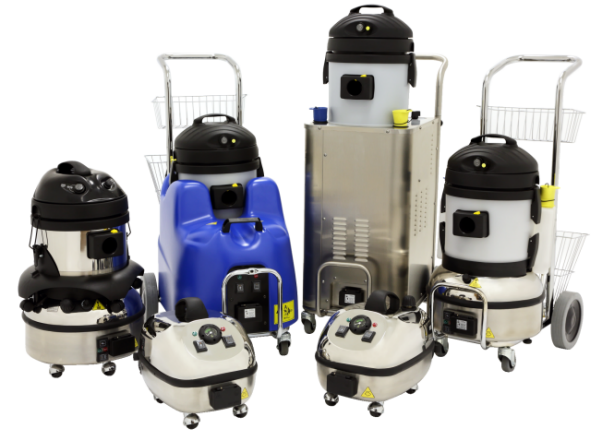Buyer's Guide to Steam Cleaners
Overview
Steam cleaners were invented in Italy more than twenty years ago and have recently become popular with consumers and commercial customers in the U.S. The products use only vaporized water to clean and disinfect. This type of chemical-free cleaning is effective for sanitizing food and healthcare environments, as well as eliminating allergens, such as dust mites and molds.
Note: Steam cleaners can also clean with chemicals and many machines include detergent tanks. Daimer recommends non-toxic green chemicals, such as its line of Eco-Green®.
The machines use superheated water, also known as dry vapor containing only about 5% water in the vapor, to remove dirt, grime, oil, grease and stubborn buildup and stains. As a result, steam cleaners are ideal for spot cleaning upholstery/carpet cleaning, hard surface. floor cleaning, tile and grout cleaning. Clean appliance surfaces, counter tops, bathrooms, vinyl floors, sealed hardwood floors, and so much more. Because of the high temperatures, the devices should not be used on soft plastics that are susceptible to melting when heat is applied to them, or other easily melted surfaces.
Steam cleaners reach pressure levels of up to 150 psi and temperatures of up to 360°F, depending on the model. Other professional-grade products, such as power washers, generate higher levels of pressure but clean using water or wet steam, which is inappropriate for dry steam cleaner applications.
Key Features
Continuous Refill:
Steam cleaners with this feature have two water chambers -- a pressurized boiler tank and a non-pressurized tank. To refill the machines, water is added to the non-pressurized tank. This allows for non-stop operation of the machines.
Daimer vapor steam cleaners take this technology a step further by managing internal boiler tank refills very precisely with a patented electro-mechanical device. As a result, the machines avoid drops in pressure and temperature during use.
Boiler Size:
For products without continuous refill, the larger the boiler size, the longer the product can operate between refills. Boiler sizes can range from 4 liters residential/light commercial steam cleaners to 14 liters for machines designed for industrial applications.
Replaceable heating elements:
This technology saves money because customers can have a single low-cost heating rod replaced instead of a costly boiler.
Vacuums:
Some steam cleaners come with wet/dry vacuums that empty their contents automatically into extraction tanks. Wet vacuums save time because users can clean without the use of towels. Non-vacuum steam cleaners require the use of a towel to wipe residue left behind.
Daimer's wet/dry vacuums remove allergens and dust, which can simply be poured down a drain or toilet.
Detergent Chambers:
These tanks hold and dispense cleaning chemicals. Some steam cleaning machines include simple handle controls that allow the operator to control the detergent and steam flow while cleaning. Detergent chambers can range in size from 3 liters for residential/light commercial machines to more than 20 liters for equipment designed for industrial applications.
Extraction Chambers:
Waste from the vacuum -- detergent, water and dry debris -- is dumped into an extraction chamber for removal at a later time. These chambers can range from 4 liters to 35 liters.
Special Sanitizing Features
For applications in healthcare and food service environments, consider steam cleaners with enhanced features for eliminating microorganisms.
Advanced Thermal Ionic Sanitization ™ (ATIS®) is a technology that killed 99.99% of disease-causing bacteria and mold in independent tests conducted by a nationally recognized laboratory
A water-filtration-based vacuum featuring a high efficiency particulate air (HEPA) filter, which traps allergens and bacteria, is also worth considering. Vacuums draw in air, which gets expelled through the machine. Passing the expelled air through a HEPA filter prevents the spread of harmful particles.
Small Detail Brushes
Be sure to check brush prices before buying a steam cleaner. Small detail brushes account for up to 99% of all accessories customer purchases after buying a steam cleaner. Daimer charges as little as $2.50 a brush. Some steam cleaner vendors charge more than $20 a brush. So, if you used 100 brushes, Daimer replacements would cost $250 as compared to competitors' brushes at $2000 -- or as much as a new steam cleaner.
These little brushes are ideal for cleaning grout and other surfaces depending on the firmness of the bristles. Stainless steel detail brushes are ideal for applications requiring the most abrasion, such as removing carbon buildup from restaurant grills. Brass brushes are slightly softer and ideal for cleaning stubborn substances off metal surfaces. Use nylon brushes for the most delicate surfaces.
More Information about Steam Cleaners
Expand your business by using chewing gum removal equipment for cleaning tile and grout.
Learn how a steam cleaner works.
Five questions to ask before buying a steam cleaner.
Daimer's 150 KleenJet® models.
Comparison chart of current specials.
Using a steam cleaner on hardwood floors.
Avoid steam cleaner brush rip-offs.
The differences between carpet steam cleaners, steam cleaners, and steam pressure washers.
